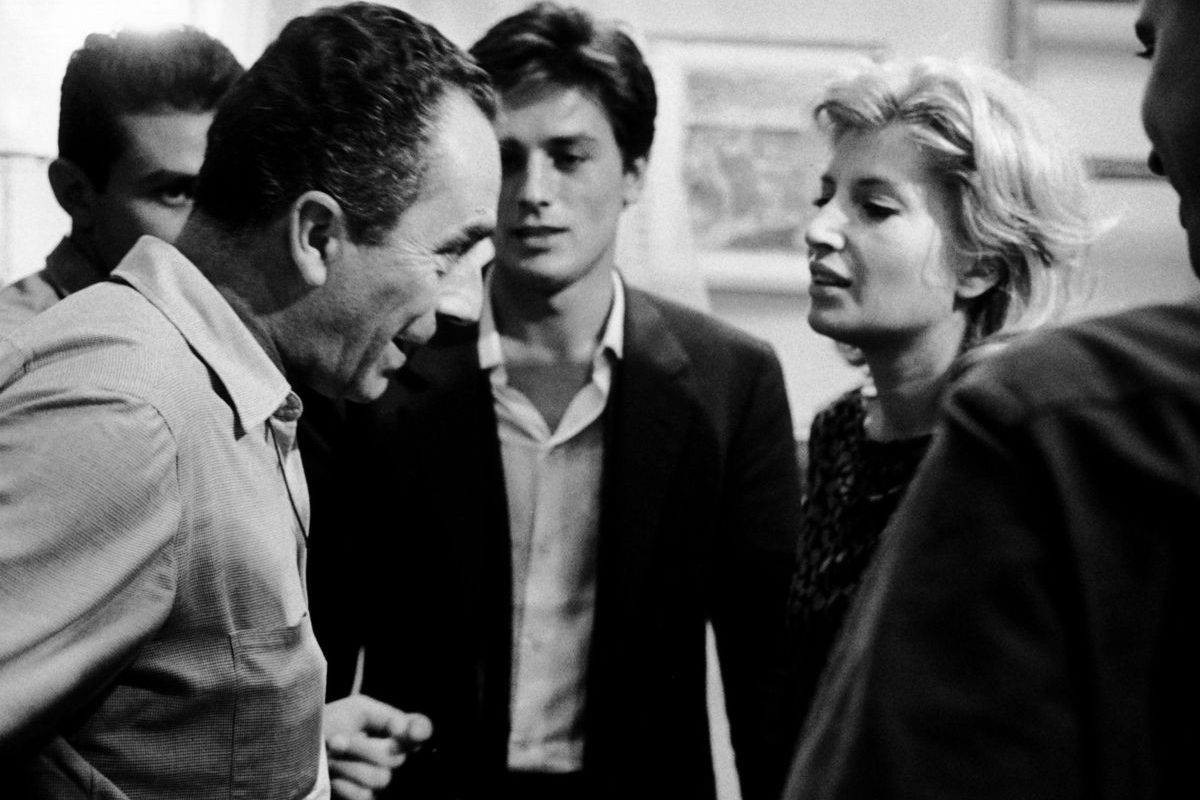
The scope of this essay is to present a peculiar aspect of Michelangelo Antonioni’s work. Our intention was not to offer a complete analysis of his works and their components (which are nonetheless excellent), moreover to investigate and focus on a specific aspect of his working method: the actors’ direction and the consequent operation of mise-en-scene. Starting from this detail in order to get to a more general look on his career, Antonioni’s constant balance between different aesthetics forces – so peculiar of his films – reveal itself on the surface of the image.
Framing
Antionioni’s work has always been characterized by a profound formal tension that was never detached from the narrative body of the films. This proximity makes completely pointless the critiques that his films were made under the sign of a vacuous formalism – or often misinterpreted as decadentism.
This formal tension (that becomes attention and care of) is noticeable in every frame/composition: Antonioni thinks that the space, as we know, is a composition element. What becomes fundamental is the relation between the elements of the frame.
Antonioni himself says that “for an image to be necessary, it’s essential that every inch that forms it is necessary, too.”(1) A recurring theme in Antonioni’s work is the narrative structure based on the old suggestion of the journey, which is “adventure, retrace, escape, research of identity”(2): this is not only the factor that moves his narration, but also it is very often the reason that moves his camera as well (The Passenger – 1975). So, amongst the elements forming the composition (and the narratives) there’s the actors and their direction as the director himself says: “the actors are one of the elements in the frame”.
Cronaca di un amore
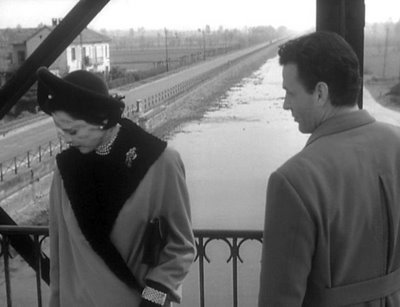
It is very useful to begin this analysis with the first feature film of the director from Ferrara which represents a very interesting starting point. In Cronaca di un amore (Chronicle of a Love), one of the most famous sequences (the one on the bridge), Antonioni sets up the staging and the action in a way that, when Guido is recapping the plan to kill Paola’s husband, she would move in an evasive fashion getting further from him. The camera is positioned at the centre of the circular movement of the couple and starting a simple (but very effective) succession of pans and trackings. There’s no cuts and the continuity of the scene stays internal to the frame, refusing to refer to a form of analytical montage, the only montage is within the composition itself.
In details, it’s highly noticeable how Antonioni tries to disorientate the spectator with an in image in a long shot which seems to attribute a meaning to the car we can see in the far distance. Then, the camera pans to the right and reveals Paola: the car we can see is following the same path her husband will on the murder night. Guido reaches her and tell her that the plan will not fail.
The woman, clearly nervous, turns herself to avoid him (hiding her face) and walks to the other side of the bridge (still hiding herself). He follows her and turns her, while she looks absent-minded to the road of the killing. Paola leaves him and the frame on the right, but he reaches her again. She leaves the frame once more and Guido, more resolute, faces her: he reminds her they’ve killed someone already and she was his accomplice. She goes back and tell him that he “killed her!”. Guido walks violently back in frame and slaps her.
The acting direction shows how, for the fact that the exclusive focus of the image is on her, the sudden entrance of him in frame results in a more violent and aggressive feeling(3): a perfect demonstration of how Antonioni constitutes the acting in his films, more like a movement of bodies (almost sculptural) than an emotive one. As Bertetto notes “Antonioni directs the actor not only as a vector that reveals interiority, but more like a sign which has to be coherently inserted in a frame constituted through a principle of artistic formalization”(4).
Position of the body
It’s now becoming more clear the staging of the acting that will accompany Antonioni throughout his entire career: the actors move in relation to their position to the camera and the other “elements” within the frame (i.e. a wall, a corner of a building, an object or a cupboard). “I think that the frame is a plastico (sculpture), a figurative object to be seen in the right dimension” – says Antonioni – “The acting has a value in relation to the frame: a line said from an actor at three-quarters is different from a line said facing the camera on on the profile: it has a different value, a different meaning.” (5)
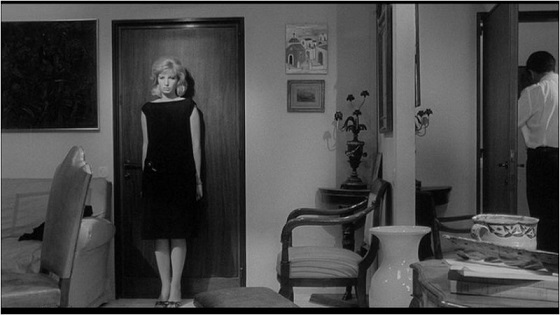
An example of this is in the initial scene of L’eclisse in which Monica Vitti, in the role of Vittoria, is framed from the back of the shoulders while she moves slowly and laterally, in front of Francisco Rabal (Vittorio) who remains sat with his absent-minded gaze. Rabal’s position stays static in the frame, while the position of Vitti’s head and the objects all around him change. (6)
Another recurrent stylistic peculiarity for Antonioni finds space in this film: the characters appear after the camera’s gaze is already been fixated on a background. This stylistic sign will accompany the director during all his path (which will ultimately lead him towards a cinematographic form of abstractism) as you can see in the first scene of Identificazione di una donna (Identification of a woman) which opens on an unintelligible frame. “An arabesque in frame is contradicted by geometrical and regular campiture. Quite soon on this decorative collage the action starts: the protagonist walks in his own house. We see him from the top and we understand that the initial configuration is nothing else that the floor of the entrance surrounded by the furniture” (7). In this case too, the director’s attention is towards the matter (and definitely not only organic matter) that is the final object of his gaze.
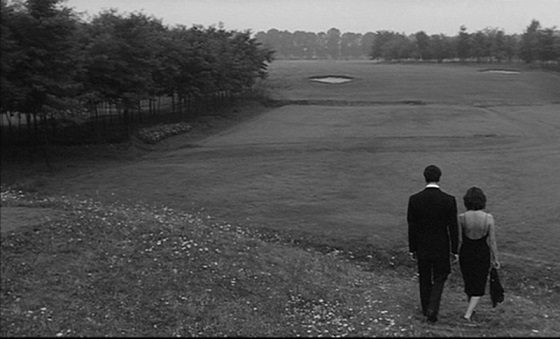
So, Antonioni’s framing investigate the space in relation the sense of movement – ofter a character movement – studied within the frame as it happens, for instance, in La signora senza camelie. In this film the characters are framed from a top angle in the two most crucial moments: the audience after the projection in Venice; the characters in the same room where Gianni tried to take his own life.
Instinct
Once we have affirmed what the effects are of his framing characteristcs in relation to the directions of the actors, it’s now important to focus on the methods that Antonioni would use to push the actors towards what he wanted from them: to be stone from which one can sculpture, the actor had to accept notes from him that would never go in the sense of a psychological deepening. Paradigmatic, in this sense, the experience of Jeanne Moureau in La notte: it almost seems like Antonioni deliberately avoided to give any information to Moreau on the role she was portraying and on the film in general, forcing her to work in an opposite direction in regards to her classical theatre formation (in 1948 she was in the Comédie Française(8)).
Antonioni, in fact, gave her very few explanations while still going to long extent to explain his core concept:” If this behaviour is true, it’s born from the intention to consider the acting as one of the tools that a director needs to express an idea, both figurative and conceptual. I push myself to solicit in the actors the instinct more than the brain” (9).
Therefore, in the director’s mind there’s a very precise connotation of the actor’s role: more than his reasoning, more than the identification, Antonioni is looking for the instinct which makes his formal idea well more realistic. It’s really in the movement between the formal tension and the reality concept (which in Antonioni is a thin and suffered concept) that his entire staging operation is resolved: always in the order of a relation between a general (environment, background, social) and one detail (an object, a character). Tinazzi underlines that “as always happens in Antonioni, the ending that represents the solution is figured in a long shot that immerses the figures in a meaningful environment.” (10)
The realism
Reality then, but in order to understand how Antonioni is in relation to it we have to move our lens to a frame of his first short-film Gente del Po (which was identified from the director himself as his neo-realist experience). It’s a frame that can be seen, retrospectively, as a manifesto of his own poetica: a pan that starts from a detail (a sickle) and in its journey encounters some (female) figures (in a medium shot) before stopping on another character. The director, on his first experience, shows his interest in the dynamics that correlate the (social, but not only) environment to the influence that an individual receives from it – and this seems to be the facet of reality that really interests him to the core. It’s in fact obvious that the shot is well organized, in contrasts to the neo-realist canone which the same director didn’t hide in regards to this opera. Doing so, he would display the attempt to enlarge the boundaries of the neo-realism he was forced in (especially from the critics). Few years later, in the recall in Blow-Up, the way this frame can be seen as a manifesto will become more clear, as well as the self-awareness of the director in regards to it.
A case in which this friction border between reality and form is in short-circuit is in his short-film Tentato Suicidio, inside the collective work organized by Cesare Zavattini L’amore in città (Love in the city). Here the artificiality (more than the staging) is extremely clear in the way the actors act. The work had a starting point of an attempt to capture the reality with no filters or manipulation attached, but it reveals itself as artificial and fake, because the “actors” – which weren’t actors at all, but the actual people involved in the facts depicted by the film, which Antonioni almost draws as if they staged the suicidal acts more than lived – weren’t using their instincts, but tried to re-live their feelings and acting them in front of the camera: the end result is terribly fake. This is probably what gave Antonioni the push to find a different methodology in working with his actors trying to avoid the adherence between character and actor.
Methodology
If
all of this concurs into the creation of a method – in the
directions of the actors as well as in the construction of the film –
this method seems to be born under its clash-encounter with the
reality. As De Vincenti points out “The most «aesthetical» of our
filmmakers and the most «constructed» of all our cinematographical
examples return to a «free» and «improvised» relation with the
reality.” (11).
Antonioni usually prepared a canovaccio
of all the frames he wanted, but very often his decisions on the way
the frames and compositions were to be shot were taken on the set: he
was usually seen wandering around the locations, alone and very early
in comparison to the rest of the crew. Through this immersion in the
reality, the director would go for an aesthetic choice or another,
trying to be receptive of the environment inspiring him.
In regards to the actor’s direction, this method would result in a sort of a “non-method” which is in direct connection to the high grade of flexibility and adaptability as “each and every actor requires a different treatment”(12): violent as it happened with Lucia Bosè (which Antonioni even slapped on the face on the Cronaca di un amore set in order for her to reach the emotive level he was after (13); or the case of Betsy Blair for whom Antonioni started to “suddenly invent things, to understand what she wanted to know and explain things that didn’t correspond at all to the things [he] wanted to say” (14); or for Il grido with Steve Cochran which had to be directed “using the opposite direction […]. I had to direct him with tricks and things without let him understand what I wanted from him, but obtaining this through the use of the means that he would not suspect(15)”.
The
actors reactions were not always, as one can imagine, condescending.
On the set of La notte
there were basically two groups: on one side the director and Monica
Vitti, on the other Marcello Mastroianni and Jeanne Moreau – who
was already complaining about the lack of directions from the
director in regards to the character, although even in this situation
Antonioni managed to get from her a very powerful interpretation full
of shades – in regards to the special treatment that Monica Vitti
would receive from the director (18).
Mastroianni himself
confessed to Tullio Kezich that he was about to send a letter to
Antonioni in which he “wanted to protest, black on white, for the
way he [Antonioni] would behave with the actors. He [Antonioni] tells
you nothing, he doesn’t give you any form of confidence, keeps
everything to himself and treats you like as a scene
furninshing”(19). He probably sent that letter that Antonioni very
likely, as Kezich points out, put straight in the bin.
Another case study could be the escape of Richard Harris before the end of the production on Deserto Rosso (Red Desert) (20.)
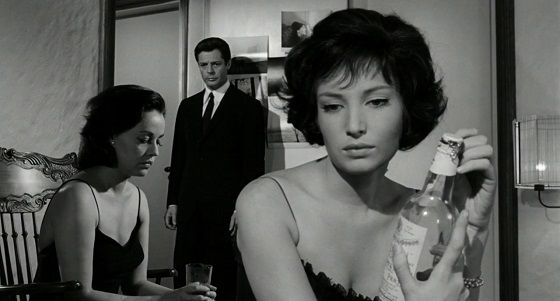
So, acting is nothing else than another index that tells that Antonioni’s work wouldn’t stop in the narrative context and the staging organised to the detail in pre-production, as for instance would happen in the work of another maestro like Alfred Hitchcock.
The formation and creation were fruits of this clash with reality – in Antonioni, reality is often rendered stylistically as environment, the general that presses the individual. This allowed the director, who was definitely receptive to it, to take aesthetics and style directions that were new and in open break with the rest of the international cinematography.
Although, the functions of the actors within the frame can be thought to be similar to the ones Hitchcock used – Jacques Aumont would signal “The perfect metaphor [of H. staging techniques] can be seen in The birds, with the frame of Melanie Daniels trapped inside the glass prison of the phone booth, and the actress, to whom was imposed not to act the confusion and wasn’t given the word, would just push her hand and her face against the glass and make them match the point where the glass is crumbling under the seagull pecking” (16) – Antonioni’s formalization works not only in the direction of a communicative sense of feeling (which in Hitchcock happens also on the editing level) but also (if not mainly) in the pure loosening of the dramatics mechanisms and in a composition form that displays the complex equilibrium between individual and environment, point that, for the director, is the place where the clash and the creation can exist.
The individual and the context.
The character (and the actor) in some of Antonioni’s films seem to casually walk in the order of the things as for example happens for Monica Vitti in L’avventura. Around the third minute of the film she walks in frame on the background almost randomly and then walks from the right to the left and goes out to the left of the profilmico, revealed again from the camera movement that follows the same path. The character is there and it’s discovered exclusively by the presence and the use of a camera.
The acting and the actor’s direction in Antonioni is always bearer of the sense that the director gives to the individual inside the stories (and History, more on general terms).
Emblematic in this sense is the beginning of Zabriskie Point with the meeting of the collective that is framed through documentary stylistic features, allowing the environment and the individual to fuse together (the meeting is in fact against the “bourgeois individualism”). Nonetheless, the emerging of one figure (Mark) against the collective, brings everything back to the “classic” set-up of the director.
Mark
moves borderline to the context, he wants to be more incisive, he
doesn’t want to wait for things to get at the lowest before acting
and therefore places himself in a position of clash against the rest
of the social context.
Even more poignant to this concept is
Daria’s character presentation: to her is forbidden the access to the
high places. Therefore she can’t have any vertical movement (or
social climbing). She’s only allowed to this by Lee Allen (Rod
Taylor, actor in Hitchcock’s The
Birds)
as a personal favour.
The characterisation of the character happens on spacial and movement themes and with no weight on her emotive or pathos-driven side: it’s natural therefore that the characters and the acting of the actors are exclusively to be ascribed to the movement, the space and ultimately to the cinematographic image which is nothing but movement.
Even more specifically, the demonstration for this is in the fact that the two characters of the film share and emerge in absence of movement: vertical for Daria; horizontal for Mark metaphorized on the stasis of the collective that focus more on the speculative side of things than the active itself.
Michelangelo as “pure cinema”
“Michelangelo” – says Kezich – “was pure cinema” (21) and the contrasts with the actors who had a theatrical formation (for instance Mastroianni (22) are not too odd: Antonioni has always affirmed, rightly so for his idea of cinema, that the only person who can have an idea about the film in its totality – and therefore knows how to handle the “material” and the elements of a film – is the director. The director is to be intended like the only one who can organize the movement of the camera and the film in general. Not the actors, then, whose interests can become a risk against the stylistic unity of the text as it undermines the film’s foundations adding a new “creativity” that the cinema of Antonioni is not in search of and is genuinely afraid of.
A sequence out of Blow-up, echo the frame in Gente del Po that we’ve already talked about. It presents the director dealing with the analysis of his work idea, his interests and his difficulties: at the beginning of the film Thomas is working on two actual photo shoots in the studio (actually, the second seems more like split in other two parts). In first session, Thomas has an individual contact with the woman and stages his own desire (an instinctive way more than a reason driven approach to the Other) and some sort of awareness/consciousness of his own job (the session does seem ending on a simulation of a sexual intercourse and the simulation itself is a very important factor in the film); in the first of the two micro-sesssions of the second photo shoot, the photographer is struggling with a group photo. What stops the photographer in his work is the chaos that appear in front of his eyes. The (social, in this case) dis-organization disorientates Thomas who’s not able to find interesting points and fixate his camera.
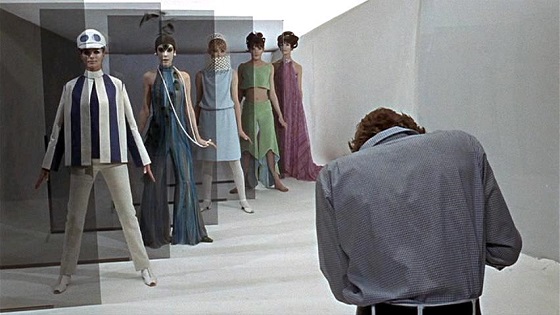
The issue is then resolved in the second micro-session that will ultimately see the group staged and messo-in-forma, a new order to the image given by the artistic composition. It’s then self-explanatory the relation that his “creation” is looking for with the reality, and the subsequent threat that a second “creation” made by the actors posed to the unity of the film.
And now, if in Blow-up, the sense can disappear so much that it becomes pure simulation and appearance, the final and most extreme act that the work of Antonioni does – challenging the cinema itself – can finally happen: the disappearance and the definitive abstraction of (and from) the character.
Professione: Reporter (The Passenger) evolves around the identity (and the research for it) of the protagonist (Jack Nicholson). In the final sequence (one of the most famous in his cinema – masterfully shot with a long-take (23)) we understand there’s no longer any character: the camera and its gaze are now completely free from the character and can wander fluctuating as if waiting for the destiny to happen. It’s six minutes of pure visual movement (obviously marked by an extreme preparation and organization) and when the shot complete its 360° rotation we see the character, dead in his own room. What’s left behind is only the shape, the form, the artistic creation (probably born out of destruction) and a character that seem definitively abstract and immaterial.
Cinema that, once more, in his hands, becomes pure movement. And, the only way we can pay a tribute to Antonioni is by silencing our words and leave the conclusion to the image.
You don’t know what film to watch tonight? Please have a look at our Film Alphabet page.
Notes:
(1)Michelangelo Antonioni, Fare un film è per me vivere, Marsilio Editori, Venezia, 2009, p. 125
(2)Ibidem, p. XIII
(3)David Bordwell, Kristen Thompson, Storia del cinema e dei film, McGraw-Hill Companies, Milano, 2010, pp.506-509
(4)Paolo Bertetto, a cura di, Azione!, minimum fax, Roma, 2007, p. 28
(5)Michelangelo Antonioni, op.cit., p. 9
(6)David Forgacs, Michelangelo Antonioni in Azione!, Paolo Bertetto (a cura di), minimum fax, Roma, 2009, p. 206
(7)Giorgio de Vincenti, Michelangelo Antonioni e la pittura del secondo dopoguerra, in Il concetto di modernità nel cinema, Pratiche editrice, Parma, 1993, p.199
(8)Ibidem, p. 207
(9)Michelangelo Antonioni, op.cit., p. 17
(10)Giorgio Tinazzi, Michelangelo Antonioni, Il castoro, Milano, 2013, p.79
(11)Giorgio de Vincenti, op.cit. , p.208
(12)Michelangelo Antonioni, op.cit., p.48
(13)David Forgacs, Michelangelo Antonioni in Azione!, Paolo Bertetto (a cura di), minimum fax, Roma, 2009, p. 212
(14)Michelangelo Antonioni, op.cit., , p.10
(15)Ibidem, p.11
(16)Jacques Aumont, Alfred Hitchcock, in Azione!, Paolo Bertetto (a cura di), minimum fax, Roma, 2009, p. 98
(17)Giorgio Tinazzi, op.cit., p. 115
(18)Tullio Kezich, La presa del potere dei dir-actors, in Azione!, Paolo Bertetto (a cura di), minimum fax, Roma, 2009, p. 49
(19)Ibidem, p. 50
(20)Ibidem, p.52
(21)Ibidem, p.51
(22)ivi
(23)A recap is quoted in Fare un film è per me vivere